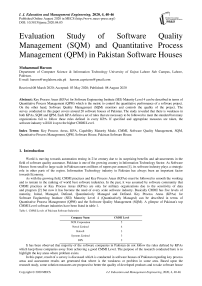Evaluation Study of Software Quality Management (SQM) and Quantitative Process Management (QPM) in Pakistan Software Houses
Автор: Muhammad Haroon
Журнал: International Journal of Education and Management Engineering @ijeme
Статья в выпуске: 4 vol.10, 2020 года.
Бесплатный доступ
Key Process Areas (KPAs) for Software Engineering Institute (SEI) Maturity Level 4 can be described in terms of Quantitative Process Management (QPM) which is the metric to control the quantitative performance of a software project. On the other hand, Software Quality Management (SQM) monitors and controls the quality of the project. The survey conducted in this paper covers around 20 software houses of Pakistan. The study revealed that there is weakness in both KPAs, SQM and QPM. Each KPA defines a set of rules that are necessary to be followed to meet the standard but many organizations fail to follow these rules defined in every KPA. If specified and appropriate measures are taken, the software industry will lift it up to the higher CMMI Level.
Key Process Areas, KPA, Capability Maturity Mode, CMMI, Software Quality Management, SQM, Quantitative Process Management, QPM, Software House, Pakistan Software House
Короткий адрес: https://sciup.org/15017264
IDR: 15017264 | DOI: 10.5815/ijeme.2020.04.05
Список литературы Evaluation Study of Software Quality Management (SQM) and Quantitative Process Management (QPM) in Pakistan Software Houses
- Heeks, R.B. (2002) i-Development not e-development, Journal of International Development, 14(1): 1-12.
- Current Trends In The Adoption Of The CMMI Product Suit, Dave Zubrow, 27th Annual international computer software and application conference 2003.
- Kit, E., Software Testing in the Real World: Improving the Process. Addison-Wesley, Reading, MA, USA, 1995.
- Tassey, G., The Economic Impacts of Inadequate Infrastructure for Software Testing. U.S. National Institute of Standards and Technology report, RTI Project Number 7007.011, 2002.
- Paulk M. C., Weber C. V., Garcia S. M., Chrissis M. B., and Bush M. (1993). Key Practices of the Capability Maturity Model, Version 1.1. Technical Report CMU/SEI-93-TR-025 ESC-TR-93-178, Software Engineering Institute, Carnegie Mellon University, Pittsburgh, Pennsylvania.
- Paulk M. C., Weber C. V., Curtis B., & Chrissis M. B. (1995). The Capability Maturity Model: Guidelines for Improving the Software Process. Addison – Wesley, Boston
- Sommerville, I. (2011). "Chapter 24: Quality Management". Software Engineering (9th ed.). Addison-Wesley. pp. 651–680. ISBN 9780137035151.
- Zsolt, U. (February 2014). "Software quality management". Software Development Processes and Software Quality Assurance. University of Pannonia. pp. 117–121. Retrieved 7 December 2017.
- Sommerville I. (2006). Quality Management. Software Engineering, 8th edition. Chapter 27 Slides. AddisonWesley, England.
- Humphrey W. S. (2008). The Software Quality Challenge. CROSSTALK: The Journal of Defense Software Engineering. pp 4 - 9.
- Sowunmi O. Y., Misra S., Fernandez-Sanz L. , Crawford B. and Soto R. (2016). An empirical evaluation of software quality assurance practices and challenges in a developing country: a comparison of Nigeria and Turkey.SpringerPlus20165:1921. DOI: 10.1186/s40064-016-3575-5.
- Malik Hneif, Siew Hock Ow, “Review of Agile Methodology in Software Development”, IJRR in Applied Sciences, Vol 1 Issue 1, Oct 2009.
- Moses Kehinde Aregbesola, “Evaluation of Quantitative Process and Software Quality Management in the Nigerian Software-House”, International Journal of Computer Applications, Volume 168 No.1, June 2017. [14] Aregbesola M. K. and Oluwade B. A. (2014). An Experimental Evaluation of Defect Prevention and Change Management in Software Process Optimization in the Nigerian Software Industry. ARPN Journal of Systems and Software Vol.4, No.1, pp. 5-11.
- Hikichi K., Yonemitsu T., Fukuchi Y., Fushida K. and Iida H.(2005). An assistance method of incorporating quantitative management indicator into software development process. Hitachi, Ltd., Shinagawa, Tokyo, Japan.


